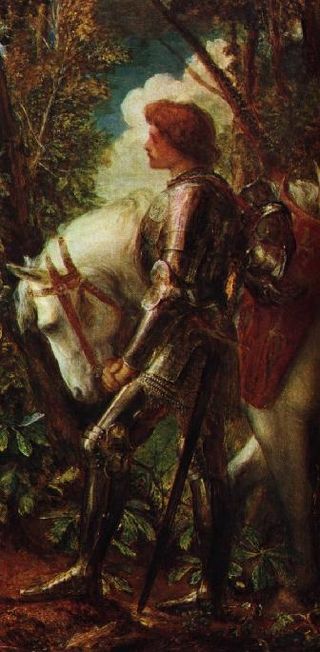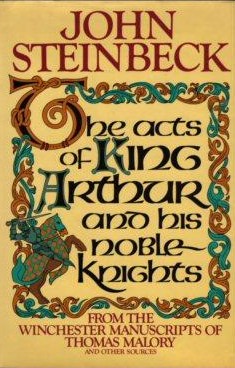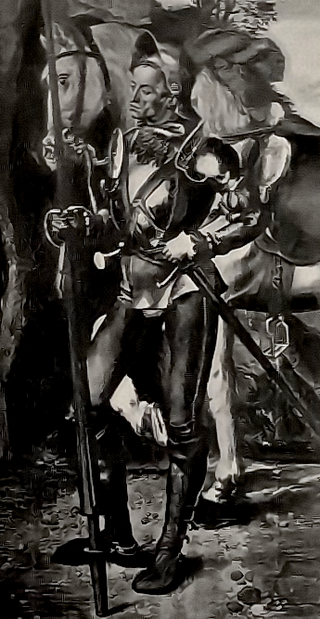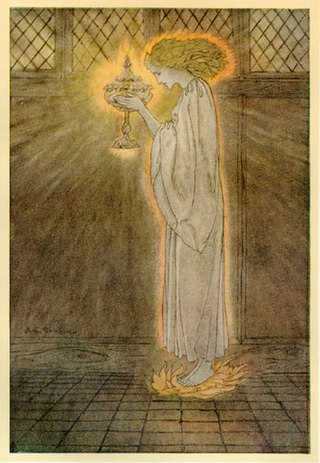Related Research Articles
Sir Thomas Malory was an English writer, the author of Le Morte d'Arthur, the classic English-language chronicle of the Arthurian legend, compiled and in most cases translated from French sources. The most popular version of Le Morte d'Arthur was published by the famed London printer William Caxton in 1485. Much of Malory's life history is obscure, but he identified himself as a "knight prisoner", apparently reflecting that he was either a criminal, a prisoner-of-war, or suffering some other type of confinement. Malory's identity has never been confirmed. Since modern scholars began researching his identity the most widely accepted candidate has been Sir Thomas Malory of Newbold Revel in Warwickshire, who was imprisoned at various times for criminal acts and possibly also for political reasons during the Wars of the Roses. Recent work by Cecelia Lampp Linton, however, presents new evidence in support of Thomas Malory of Hutton Conyers, Yorkshire.

Guinevere, also often written in Modern English as Guenevere or Guenever, was, according to Arthurian legend, an early-medieval queen of Great Britain and the wife of King Arthur. First mentioned in popular literature in the early 12th century, nearly 700 years after the purported times of Arthur, Guinevere has since been portrayed as everything from a fatally flawed, villainous, and opportunistic traitor to a noble and virtuous lady. Many records of the legend also feature the variably recounted story of her abduction and rescue as a major part of the tale.

Gawain, also known in many other forms and spellings, is a character in Arthurian legend, in which he is King Arthur's nephew and one of the premier Knights of the Round Table. The prototype of Gawain is mentioned under the name Gwalchmei in the earliest Welsh sources. He has subsequently appeared in many Arthurian tales in Welsh, Latin, French, English, Scottish, Dutch, German, Spanish, and Italian, notably as the protagonist of the Middle English poem Sir Gawain and the Green Knight. Other works featuring Gawain as their central character include De Ortu Waluuanii, Diu Crône, Ywain and Gawain, Golagros and Gawane, Sir Gawain and the Carle of Carlisle, L'âtre périlleux, La Mule sans frein, La Vengeance Raguidel, Le Chevalier à l'épée, Le Livre d'Artus, The Awntyrs off Arthure, The Greene Knight, and The Weddynge of Syr Gawen and Dame Ragnell.

Galahad, sometimes referred to as Galeas or Galath, among other versions of his name, is a knight of King Arthur's Round Table and one of the three achievers of the Holy Grail in Arthurian legend. He is the illegitimate son of Sir Lancelot du Lac and Lady Elaine of Corbenic and is renowned for his gallantry and purity as the most perfect of all knights. Emerging quite late in the medieval Arthurian tradition, Sir Galahad first appears in the Lancelot–Grail cycle, and his story is taken up in later works, such as the Post-Vulgate Cycle, and Sir Thomas Malory's Le Morte d'Arthur. In Arthurian literature, he replaced Percival as the hero in the quest for the Holy Grail.

Tristan, also known as Tristram, Tristyn or Tristain and similar names, is the folk hero of the legend of Tristan and Iseult. In the legend, his objective is escorting the Irish princess Iseult to wed Tristan's uncle, King Mark of Cornwall. Tristan and Iseult accidentally drink a love potion during the journey and fall in love, beginning an adulterous relationship that eventually leads to Tristan's banishment and death. The character's first recorded appearance is in retellings of British mythology from the 12th century by Thomas of Britain and Gottfried von Strassburg, and later in the Prose Tristan. He is featured in Arthurian legends, including the seminal text Le Morte d'Arthur, as a skilled knight and a friend of Lancelot. He is also a Knight of the Round Table.

The Knights of the Round Table are the legendary knights of the fellowship of King Arthur that first appeared in the Matter of Britain literature in the mid-12th century. The Knights are an order dedicated to ensuring the peace of Arthur's kingdom following an early warring period, entrusted in later years to undergo a mystical quest for the Holy Grail. The Round Table at which they meet is a symbol of the equality of its members, who range from sovereign royals to minor nobles.

Bedivere is one of the earliest characters to be featured in the legend of King Arthur, originally described in several Welsh texts as the one-handed great warrior named Bedwyr Bedrydant. Arthurian chivalric romances, inspired by his portrayal in the chronicle Historia Regum Britanniae, portray Bedivere as a Knight of the Round Table of King Arthur who serves as Arthur's marshal and is frequently associated with his brother Lucan and his cousin Griflet as well as with Kay. In the English versions, Bedivere notably assumes Griflet's hitherto traditional role from French romances as the one who eventually returns Excalibur to the Lady of the Lake after Arthur's last battle.

Le Morte d'Arthur is a 15th-century Middle English prose reworking by Sir Thomas Malory of tales about the legendary King Arthur, Guinevere, Lancelot, Merlin and the Knights of the Round Table, along with their respective folklore. In order to tell a "complete" story of Arthur from his conception to his death, Malory compiled, rearranged, interpreted and modified material from various French and English sources. Today, this is one of the best-known works of Arthurian literature. Many authors since the 19th-century revival of the legend have used Malory as their principal source.

In Arthurian legend, the Siege Perilous is a vacant seat at the Round Table reserved by Merlin for the knight who would one day be successful in the quest for the Holy Grail.

The Acts of King Arthur and His Noble Knights (1976) is John Steinbeck's retelling of the Arthurian legend, based on the Winchester Manuscript text of Sir Thomas Malory's Le Morte d'Arthur. He began his adaptation in November 1956. Steinbeck had long been a lover of the Arthurian legends. The introduction to his translation contains an anecdote about his reading them as a young boy. His enthusiasm for Arthur is apparent in the work. The book was left unfinished at his death, and ends with the death of chivalry in Arthur's purest knight, Lancelot of the Lake.

Astolat is a legendary castle and town of Great Britain named in Arthurian legends. It is the home of Elaine, "the lily maid of Astolat", as well of her father Sir Bernard and her brothers Lavaine and Tirre. It is known as Shalott in many modern cultural references, derived from Alfred Lord Tennyson's poem "The Lady of Shalott". In the Lancelot-Grail it was said to be upstream of Camelot.

Dinadan is a Cornish knight of the Round Table in the Arthurian legend's chivalric romance tradition of the Prose Tristan and its adaptations, including a part of Le Morte d'Arthur. Best known for his humor and pragmatism, he is a close friend of the protagonist Tristan. Dinadan is the subject of several often comedic episodes until his murder by Mordred and Agravain.

Brunor, Breunor, Branor or Brunoro are various forms of a name given to several different characters in the works of the Tristan tradition of Arthurian legend. They include Knight of the Round Table known as Brunor/Breunor le Noir, as well as his father and others, among them another former knight of Uther's old Round Table and the father of Galehaut.

Joyous Gard is a castle featured in the Matter of Britain literature of the legend of King Arthur. It was introduced in the 13th-century French Prose Lancelot as the home and formidable fortress of the hero Lancelot after his conquest of it from the forces of evil. Le Morte d'Arthur identified it with Bamburgh Castle.

Eugène Vinaver was a Russian-born British literary scholar who is best known today for his edition of the works of Sir Thomas Malory.
Sir Walter Fraser Oakeshott was a Transvaal-born British schoolmaster and academic, who was Vice-Chancellor of the University of Oxford. He is best known for discovering the Winchester Manuscript of Sir Thomas Malory's Le Morte d'Arthur in 1934.

Elaine or Elizabeth, also known as Amite, and identified as the "Grail Maiden" or the "Grail Bearer", is a character from Arthurian legend. In the Arthurian chivalric romance tradition from the Vulgate Cycle, she is the daughter of the Fisher King, King Pelles of Corbenic, and the mother of Galahad by Lancelot, whose repeated rape by her results in his descent into madness. She should not be confused with Elaine of Astolat, a different woman who too fell in love with Lancelot.

The Pentecostal Oath was an oath which the Knights of King Arthur's Round Table swore, according to Sir Thomas Malory's Le Morte d'Arthur. It embodied the code of chivalry. In William Caxton's printed edition, this appears at the end of book three, chapter fifteen.

The Boy's King Arthur was an abridged version of Sir Thomas Malory's Le Morte d'Arthur edited by Sidney Lanier and published in 1880. It was intended as a children's edition, alongside Lanier's other "Boy's" works. The original title, including its subtitle, was The Boy's King Arthur being Sir Thomas Malory's History of King Arther and his Knights of the Round Table. It was republished in 1950 under the title King Arthur and his Knights of the Round Table.
The StanzaicMorte Arthur is an anonymous 14th-century Middle English poem in 3,969 lines, about the adulterous affair between Lancelot and Guinevere, and Lancelot's tragic dissension with King Arthur. The poem is usually called the Stanzaic Morte Arthur or Stanzaic Morte to distinguish it from another Middle English poem, the Alliterative Morte Arthure. It exercised enough influence on Thomas Malory's Le Morte d'Arthur to have, in the words of one recent scholar, "played a decisive though largely unacknowledged role in the way succeeding generations have read the Arthurian legend".
References
- ↑ Dorsey Armstrong, Purdue University College of Liberal Arts
- ↑ Armstrong, Dorsey (2003). Gender and the Chivalric Community of Malory's Morte d'Arthur. University Press of Florida. ISBN 978-0-8130-2686-2.
- ↑ Review, The Modern Language Review , April 2005, vol. 100, no. 2, pp. 477–79
- ↑ The Journal of English and Germanic Philology Oct 2005 v104 i4 p. 570(3)
- ↑ Speculum: A Journal of Medieval Studies Oct 2005 v80 i4 pp. 1229–31
- ↑ CHOICE: Current Reviews for Academic Libraries May 2004 v41 i9 p. 1660(2)
- ↑ Malory, Sir Thomas (2009). Sir Thomas Malory's Morte Darthur: A New Modern English Translation Based on the Winchester Manuscript. Parlor Press. ISBN 978-1-60235-103-5.
- ↑ Reference & Research Book News (November 1, 2009 ; ISBN 1-60235-103-1 )
- ↑ Malory, Thomas; Armstrong, Dorsey (2009). Sir Thomas Malory's Morte Darthur: a new modern English translation based on the Winchester manuscript. West Lafayette, Ind.: Parlor Press. ISBN 978-1-60235-103-5. OCLC 405107550.
- ↑ "The Great Courses". www.thegreatcourses.com. Archived from the original on 2013-03-20. Retrieved 2021-01-13.
- ↑ Divish, Ryan (25 November 2013). "Chuck Armstrong retires as Mariners team president". The Seattle Times. Retrieved 8 June 2021.